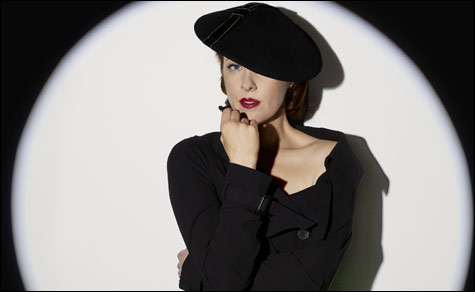
NEW YORK IS A WOMAN? Well, on Beauty and Crime, New York is Suzanne Vega. |
Suzanne Vega’s Beauty and Crime (Blue Note) is a sleek collection of New York City stories, all pop-song trim, but bubbling with an undercurrent of experimentation.
The album might just as easily be called Beauty and Sadness, if Hoboken’s Smithereens hadn’t taken that title years ago. The shadow of the World Trade Center attack hangs over the lovers and artists and socialites who populate Vega’s 11 songs, altering their visions of their lives much as the attack indelibly changed the character of New York.

You could say that Vega’s giant bite of the Big Apple is overdue. True, Boston played an important role in her national breakout. Local radio stations and concertgoers embraced her after her A&M debut, Suzanne Vega, was issued in 1985. And she was already a major star here when the follow-up, Solitude Standing, with “Luka,” a dark-hued hit about child abuse, put her on the pop charts. Nonetheless, she’s always been a New York songwriter: terse and direct, unfussy and lean with her arrangements, and devoid of the rural settings and viewpoint many folksingers favor. For Vega (who comes to the Somerville Theatre September 20), folk has always meant Greenwich Village — which, along with the Upper West Side, she’s called home.
“I spent a lot of time thinking about things in the last six years, being in New York with my daughter, walking around,” she says. “It seemed natural to write a bunch of songs that were about New York or little stories that had New York as a character.”
She considers Beauty and Crime something of a risk. Yet the elegance you hear in the rocking “Zephyr & I” (a zesty evocation of pre-9/11 bohemian life) and “New York Is a Woman” (where saxophone and clarinet join her soft, husky vocal melody to create a romantic evocation of the city’s mystique) blended with the hooks-and-beats foundations makes this album one of her catchiest sets. The 1993 99.9 F°, with its towering monoliths of hissing and puffing industry-inspired sounds, was edgier and weirder, as well as brilliant. But much of the credit for its architecture goes to her ex-husband, producer Mitchell Froom. Beauty and Crime is all Vega.
The album germinated in a quintessentially New York way. “I met Philip Glass as I was walking down the street,” she explains over the phone from, of course, Manhattan. “I run into him fairly often. And he said, ‘How’s it going?’ I said that I was without a record deal, and he looked really happy and said, ‘Congratulations. That means you can do what you really want and finally have freedom.’
“I wasn’t clear how I felt about it at the time. I wasn’t seeing it from that point of view. Two weeks after 9/11, I found out my deal with A&M was up and asked them for another year on the label, and they didn’t pick up the option, so I quietly went away.”
But she began thinking about Glass’s reaction. “I decided to hire an engineer to work with, Brit Myers, and we just played music into the computer. I riffed around and made loops and things, without lyrics. It was a new way for me to work, and part of the sleekness of these songs may be that I was working on a computer, which compresses everything and allows you to edit and alter your work in really interesting ways. It becomes like a collage. “
Myers and Vega worked on Garageband, the same program that allows high-school kids to cut songs in their bedrooms and post them on MySpace. “Some of the loops we made using Garageband ended up on the album,” she says. All the same, her acoustic guitar is the disc’s heartbeat and her breathy singing is its soul.
“I felt like I really pushed myself vocally on many of these songs. I tried to phrase differently and concentrate on the melodies. I wanted to push myself out of my comfort zone. I decided to sing in keys I wouldn’t have sung in before, work with different textures, and just do whatever sounded good to me.
“Being a performing songwriter is like being the horse and the trainer at the same time. You’re the beast that writes the songs, but you also have to train yourself to perform them correctly. Working with the computer made that much easier, since you’re able to try almost every option with what you’ve recorded.”
Vega admits that harmony singing remained her weak spot during the sessions. Eventually she hired producer Jimmy Hogarth, who’s worked with KT Tunstall and Corinne Bailey Rae, to shepherd them; Hogarth, in turn, brought Tunstall in to arrange and sing harmonies. Tunstall adds a multi-layered coating of sugar to “Zephyr & I,” making the tune sound like a refugee from the Velvet Underground’s pop masterpiece Loaded (RCA).